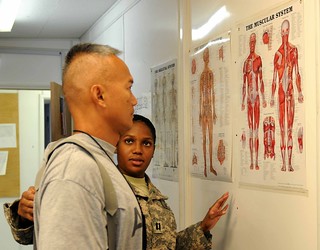By Dr. Steven Warfield
Combining the Greek words “cheir” (hand) and “praxis” (action), chiropractic is a term used to describe a medical
treatment done almost entirely by hand. Hands on therapy such as the adjustment
of the spine, is crucial to successful chiropractic care. Chiropractic
subscribes to the concept that the human body has a powerful ability to heal
itself, and that the body’s structure (namely that of the spine) is
closely related to its function, and that the relationship between the two
contribute to the individual’s overall health.
Chiropractic is the second largest healthcare
profession in the world. Chiropractic has proven uncannily adept at relieving
neck, back, shoulder, knee, wrist and headache pain, with only a series of
spinal adjustment and without the discomfort, inconvenience or risk that comes
with surgery and other invasive procedures.
Causes of spine and joint pain are numerous,
from muscle sprains, ligament injury, disc herniation, and fibromyalgia.
Chiropractic treatment is an excellent, non-surgical method for getting relief
from the discomfort and the ability to enjoy life normally again.
Most PPO's and private insurance, as well as
Medicare and Tricare, now cover chiropractic, as do all state workers
compensation programs. Let the Chiropractic physicians at The Back Institute
give you the treatment you need. Don't wait, click the button on your right or
call 904-269-2437 today to schedule your free consultation.
Back pain, for those afflicted with it, can
become a lifelong debilitating problem. They key to dealing with it is to find
the most effective way of keeping it in check. Back pain rehabilitation not
only helps reduce the severity of your back pain at the present time, but also
provides strengthening and a measure of protection from future injuries.
 Back rehabilitation strengthens the muscles
of the back, improving both flexibility as well as the overall range of motion.
Through processes in stretching strengthening, and balance, you will achieve a
wider range of motion, tolerance of and resistance to further injury, as well
as improvement of balance and posture. This process is done through the use of
various exercises and related devices such as exercise balls or resistance
equipment such as Vax-D pictured at right.
Back rehabilitation strengthens the muscles
of the back, improving both flexibility as well as the overall range of motion.
Through processes in stretching strengthening, and balance, you will achieve a
wider range of motion, tolerance of and resistance to further injury, as well
as improvement of balance and posture. This process is done through the use of
various exercises and related devices such as exercise balls or resistance
equipment such as Vax-D pictured at right.
Take steps to avoid uncomfortable or lazy
postures, and when lifting, remember to do so properly, at the knees to avoid
damage to the spine. Begin with lighter exercises, and utilize deep breathing
and other relaxation techniques to help control the level of back pain.
The expert physicians with The Back Institute
know what it takes to get you back on your feet and moving again after a back
injury. Let us help you; fill out the form to your right or call 904-269-2437
today to schedule your free consultation.
Rehabilitation Methods and Practices
• FREE consultation and initial evaluation -
review of findings with doctor!
• We help you strengthen your back and prevent
future injuries from occurring.
• Use exercise equipment to increase
flexibility and range of motion.
• We help you get back on your feet and moving
again.
Dr.’s
Steven Warfield and
Dave Edenfield offer the most advanced treatments
for back pain, sciatica, neck pain, whiplash and headaches. They
also treat auto accident victims with state-of-the-art technologies. For
more information visit http://endyourpain.org or http://chiropractic-jacksonville-fl.com













